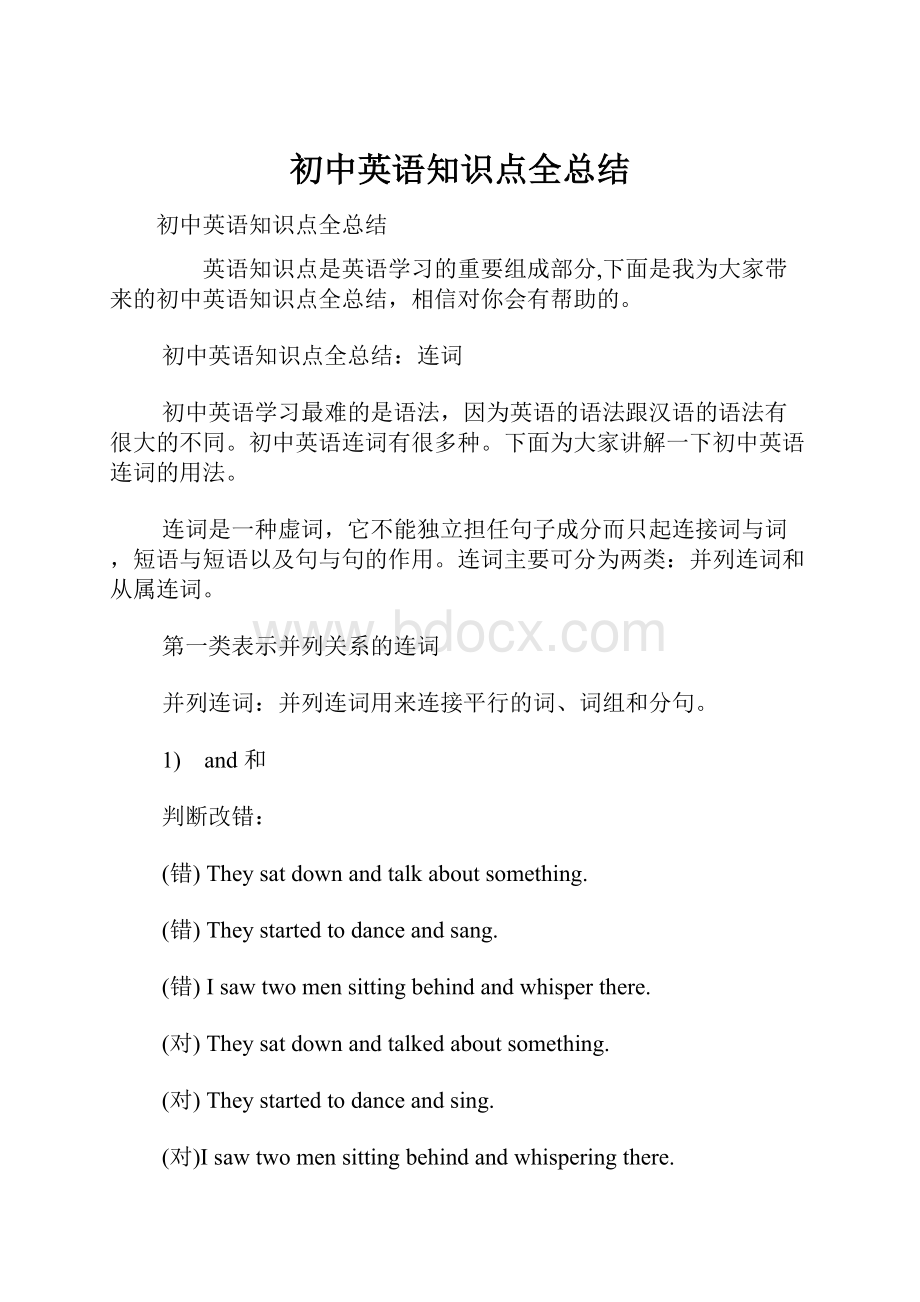初中英语知识点全总结.docx
《初中英语知识点全总结.docx》由会员分享,可在线阅读,更多相关《初中英语知识点全总结.docx(13页珍藏版)》请在冰豆网上搜索。

初中英语知识点全总结
初中英语知识点全总结
英语知识点是英语学习的重要组成部分,下面是我为大家带来的初中英语知识点全总结,相信对你会有帮助的。
初中英语知识点全总结:
连词
初中英语学习最难的是语法,因为英语的语法跟汉语的语法有很大的不同。
初中英语连词有很多种。
下面为大家讲解一下初中英语连词的用法。
连词是一种虚词,它不能独立担任句子成分而只起连接词与词,短语与短语以及句与句的作用。
连词主要可分为两类:
并列连词和从属连词。
第一类表示并列关系的连词
并列连词:
并列连词用来连接平行的词、词组和分句。
1) and和
判断改错:
(错)Theysatdownandtalkaboutsomething.
(错)Theystartedtodanceandsang.
(错)Isawtwomensittingbehindandwhisperthere.
(对)Theysatdownandtalkedaboutsomething.
(对)Theystartedtodanceandsing.
(对)Isawtwomensittingbehindandwhisperingthere.
解析:
第一句:
and连接两个并列的谓语,所以talk应改为talked。
第二句:
and连接两个并列的动词不定式,第二个不定式往往省略to,因此sang应改为sing。
第三句:
and连接感观动词saw后面的用作的宾补的两个并列分词结构,因此whisper应改为whispering。
注意:
1.and还可以和祈使句或名词词组连用表示条件。
(or也有此用法)
Makeupyourmind,andyou'llgetthechance.
=Ifyoumakeupyourmind,you'llgetthechance.
Onemoreeffort,andyou'llsucceed.
=Ifyoumakeonemoreeffort,you'llsucceed
2,AandB当表示整体或者指同一人时谓语动词用单数,当and连接的单数名词前分别有each,every,many等词修饰时,谓语也用单数。
breadandbutteraknifeandfork
Themotherandteacherisverystrictwithherson.
Noteacherandnostudentisallowedtosmokeinclass.
3.and连接的是两个相同意思的词,表示“渐渐”,或加强语气
Readitagainandagain
2) both…and 两者都
Sheplays(both)thepianoandtheguitar.
3)neither…nor意思为"既不……也不……"谓语动词采用就近原则,与nor后的词保持一致。
Neitheryounorheistoblame.
4) notonly…but(also)不但······而且······
Sheplaysnotonlythepiano,but(also)theguitar.
注意:
notonly…butalso关联两个分句时,一个分句因有否定词not而必须倒装。
Notonlydoeshelikereadingstories,butalsohecanevenwritesome.
5)aswellas以及,也,与···同样
Theteacher,aswellasthestudents,isinterestedintheactivity.
比较and和or
1)并列结构中,or通常用于否定句,and用于肯定句。
2)但有时and也可用于否定句。
请注意其不同特点:
Thereisnoairorwaterinthemoon.
Thereisnoairandnowateronthemoon.
在否定中并列结构用or连接,但含有两个否定词的句子实际被看作是肯定结构,因此要用and。
第二类表示选择关系的连词
1)or 意思为"或则"。
Whichdoyouprefer,tea,coffee,orjuice?
2)either…or 意思为"或者……或者……"。
注意谓语动词采用就近原则。
EitheryouorIamright.
3)orelse/otherwise否则
Besilent,orelseyouwillbekickedout.
Iamtired,otherwise,Iwouldplay.
第三类表示转折或对比关系的连词
1)but但是Heisrichbutunhappy.
while然而,表示对比意味Somepeoplelovecats,whileothershatethem.
yet然而Shesaidshewouldbelate,yetshearrivedontime.
however然而,可是,不过Shedoesnotlikehim,however,Ilikehim.
2)not…but…意思为"不是……而是……"
not和but后面的用词要遵循一致原则。
Theywerenotthebonesofananimal,but(thebones)ofahumanbeing.
第四类表因果关系的连词
1)for因为,做并列连词使用时,是在对先行的句子补述原因或者理由,只可以连接句子与句子,通常不置于句首。
Heisabsenttoday,forheisill.
2)so,therefore因此
Hehurthisleg,sohecouldn'tplayinthegame.
Ithink,thereforeIam
3)then那么,因而
Hidebehindthewall,thentheywon’tseeyou.
注意:
a.两个并列连词不能连用,但therefore,then,yet.可以和并列连词连用。
YoucanwatchTV,andoryoucangotobed.
Hehurthisleg,andso/andthereforehecouldn'tplayinthegame.
b.although…yet…,但although不与but连用。
(错) Althoughhewasweak,buthetriedhisbesttodothework..
(对) Althoughhewasweak,yethetriedhisbesttodothework.
从属连词
从属连词不同与并列连词,只能用来引导从句,而不能引导词或者词组。
从属连词一般可以引导名词性从句和状语从句。
第一类引导名词性从句的从属连词
1)that引导宾语从句或间接引语时,可省略。
引导主语从句时不可以省略。
Hesaid(that)hewouldcome.宾语从句
Hismothertoldme(that)heisagoodboy.间接引语
Thatsheisstillaliveistrue.主语从句
2)if/whether是否
Iwonderifheisathome.
Iaskhimwhetherhewouldcome.
注意:
只可以用whether的情况
介词后面Itwilldependonwhetheritrainstomorrow.
whether···ornot固定搭配Letmeknowwhetheryoucomeornot.
动词不定式前Idon’tknowwhethertoaccepthisadvice.
第二类引导状语从句的从属连词
1)连接时间状语从句的从属连词
before在···之前ThewarhadbeenoverbeforehecametoChina.
after在···之后HecametoChinaafterthewarwasover.
since自从IhavelivedinthiscitysinceIwasborn.
when/while当···Theteacherenteredtheclassroom,whenallthestudentswereplaying
WhenIcameintothisroom,Ifoundhimlyingbedasleep(while后接的动词是延续性的动词)
as当···IsawherasIwasgettingonthebus.
till/until直到Ididn’tgotosleepuntil/tillIfinishedmyhomework.
assoonas一···就···Assoonashesawthepoliceman,thethiefrunaway.
2)连接地点状语从句的从属连词
where在哪里TherewerelotsofparkswhereIlived.
3)连接原因状语从句的从属连词
because原因,用于解释某事的原因,动机,强调直接原因和因果关系IdoitbecauseIlikeit.
for表因为,表间接的原因,用于说明,解释Isoonwenttosleep,forIwastired
since表原因,比because弱,比as强,表一种已知的,显然的理由,常译为“既然
as表原因时,意义最弱Asyouareinpoorhealth,youshoulddomoreexercises
4)连接结果状语从句的从属连词
so···that···如此···以至于···Heissokindthateverybodylikeshim.
such···that···Heissuchakindmanthateverybodylikeshim
5)连接目的状语从句的从属连词
that/sothat/inorderthat为了
Speakclearlythat/sothat/inorderthattheymayunderstandyou.
6)连接条件状语从句的从属连词
if如果Ifitrainstomorrow,wewon’tgoonapicnic.
unless除非(如果不)Hewillcomeunlessitrains.
incase万一YoumaycallthisnumberincaseIamnotathome
7)连接比较状语从句的从属连词
than比It’seasierthanIthought.
as/so···as···和···一样Sheisastallasyou.
Heisnotas/sotallashiswife.
8)连接方式状语从句的从属连词
as按照DoasItoldyou.
Takethingsastheyare.
asif/though仿佛Hebehavesasif/thoughhewasachild.
9)引导让步状语从句的从属连词
although/though尽管AlthoughJapanissmall,thepopulationisbig.
evenif即便Evenifitwassnowingheavily,wewentonrunning.
初中英语知识点全总结:
副词
初中英语学习最难的是语法,因为英语的语法跟汉语的语法有很大的不同。
初中也要副词用法有很多种。
下面为大家讲解一下初中英语副词的用法。
副词在句中主要用作状语,修饰动词、形容词、副词、介词短语或句子。
初中英语副词的用法:
⑴修饰动词,表示时间、地点、程度、方式、频度等。
一般位于动词之后,如果动词有宾语,则要位于宾语之后。
频度副词常位于助动词和连系动词be之后或实义动词之前。
例如:
Hearrivedonlyyesterday.他是昨天才到的。
Therewereclotheslyinghereandthereonthefloor.地板上到处都是衣服。
Ihavebeenterriblyworriedaboutyouallday.我一整天都非常为你担心。
Sheplaysthepianoverywell.她钢琴弹得很好。
Theboyisalwaysaskinghisparentsformoney.那个男孩老是向他父母要钱。
Shenevergoestothecinema.她向来不看电影。
⑵修饰形容词、副词、介词短语,一般前置,只有enough例外,需要后置。
例如:
Sheseemsquitehappy.她看上去相当愉快。
You'vedoneratherbadlyinthetest.你考得够糟糕的。
Thewindwasrightinourfaces.风迎面吹来。
Thisgirlisnotoldenoughtogotoschool.这个女孩还没有到上学的年龄。
Hedidn'trunfastenoughtocatchthetrain.他跑得不够快,没有赶上火车。
⑶用作表语,多为与介词同形的副词和表示方位的副词。
例如:
Isanybodyin?
里面有人吗?
有人在家吗?
Fatherisaway.父亲离家在外。
Iamdownstairsandmybrotherisupstairs.我住楼下,我哥哥住楼上。
Myfriendisstillabroad.我的朋友还在国外。
⑷少数表示地点或时间的副词还可用作定语,一般位于名词之后。
例如:
Ihopeyou'llenjoyyourstayhere.希望你在这里过得愉快。
Imetafriendofmineonmywayhome.在我回家的路上,我碰到一位朋友。
Whatdidyouthinkofthemeetingyesterday?
你觉得昨天的会开得怎样?
⑸副词的比较等级用法与形容词一样。
初中英语副词的分类
1、时间和频度副词:
now,then,often,always,usually,early,today,lately,next,last,already,generally,frequently,seldom,ever,never,yet,soon,too,immediately,hardly,finally,shortly,before,ago,sometimes,yesterday.
2、地点副词:
here,there,everywhere,anywhere,in,out,inside,outside,above,below,down,back,forward,home,upstairs,downstairs,across,along,round,around,near,off,past,up,away,on.
3、方式副词:
carefully,properly,anxiously,suddenly,normally,fast,well,calmly,politely,proudly,softly,warmly
4、程度副词,放在被修饰词之前:
much,little,very,rather,so,too,still,quite,perfectly,enough,extremely,entirely,almost,slightly.
5、疑问副词,一般放在句首:
how,when,where,why.
6、关系副词,一般放在句首:
when,where,why.
7、连接副词:
how,when,where,why,whether.
初中也要重点副词注释:
1.as…as…常构成一些词组:
assoonas…(一旦…就…),aswellas…(同样),as+形容词/副词+aspossible(尽可能……地)。
如:
PleaseringmeupassoonasyougettoBeijing.(请你一到北京就给我写信。
)/MissGaohurriedtotheschoolgateasquicklyaspossible.(高小姐尽快地赶到了校门口。
)
[注释]"aslong/muchas+名词"可以表示"长达/多达…"的含义。
如:
Thehousecostsasmuchasfivehundredthousandyuan.(那幢房子花费高达50万元。
)/Theystayedinthecave(山洞)aslongastwoweeks.(他们呆在山洞里长达两周。
)
2.later、after、ago、before的用法:
①"一段时间+later/ago"分别表示"(多久)以后/以前",主要用于过去时态。
②"after/before+某个时刻"分别表示"在某时刻之后/之前",此时两个词是介词。
③ago与before:
ago只能用于过去时,before用于完成时。
如:
Hehadanaccidentaweekago.(一周前出了一个事故)/Someyearslater,theboybecameaveryfamoussinger.(数年后这个男孩成了著名的歌唱家)/Haveyoubeentherebefore?
(你从前到过那儿吗?
)/Afterafewyearshegaveupsmoking.(过了几年他戒了烟。
)
3.above、below、over、under的用法:
在上下方用above和below,在高低处用over和under.如:
Thestarsarehighaboveinthesky.(星星高挂在空中)/Aplaneflewoverquickly.(一架飞机从头顶飞过。
)
当above、below、over、under是介词性质时,意义相似。
4.too、also、either、nor的用法:
too("也")用于肯定句和疑问句的末尾,且用逗号隔开;also("也")用于肯定句句子谓语动词之前;either("也")用于否定句末尾,也用逗号隔开;nor("也不")用于倒装句句首;如:
AreyouAmerican,too?
(你也是美国人吗?
)/HeisnothappyandIamnothappy,either.(他不愉快,我也不。
)/Hedidn'twatchthefootballgame.NordidI.(他没有看足球赛,我也没有。
)/Youcanalsofindthemarketisverygood.(你还可以发觉那个市场很好。
)
5.enough、too、so、very、quite、verymuch的用法:
enough("足够,十分")放在形容词或副词之后;too("太")、very("非常")、quite("相当")、so("如此地")等放在形容词或副词之前,verymuch("非常")放在动词之后。
如:
It'stoo/so/very/quiteexpensive.(它太贵/那么贵/非常贵/相当贵。
)/Idon'tlikesweetsverymuch.(我不很喜欢糖果)
[注意]very与much的区别:
very修饰形容词、副词的原级和现在分词形容词,much修饰形容词和副词的比较级;much还可以修饰疑问句和否定句中的动词,very不可以。
如:
Heisverystupid.(他很笨)/Thefilmwasverymovingandeveryoneswept.(电影非常动人,大家都哭了)/Youmustworkmuchharderor